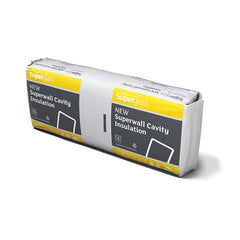
Cavity wall insulation is a game-changer for any living space. The majority of homes are built with cavity walls, which in most cases, are empty. This makes cavity wall insulation an ideal way of regulating the temperature inside your home and increasing your home’s energy efficiency.
This buyer’s guide will teach you everything there is to know about cavity wall insulation, including the basics, the different types of cavity wall insulation, the benefits, and how to determine what kind of walls you have if you are considering cavity wall insulation.
Cavity Wall Insulation: The Basics
What is cavity wall insulation?
Cavity wall insulation is used to help keep your home warmer in the winter and cooler in the summer by filling the gaps between the external walls of your property with an insulating material.
There are two types of cavity wall insulation:
- Full fill cavity
- Partial fill cavity
Installing cavity wall insulation is usually a simple process. It involves drilling very small holes into the external walls and filling the space by blowing an insulating material into it. The insulation material both traps warm air and prevents it from circulating.
Cavity insulation is a highly successful method of insulating your home, and with the correct insulation, it can last up to 25 years.
The Different Types of Cavity Wall Insulation
Foam:
Usually made of polyurethane, foam insulation is one of the most useful materials for cavity wall insulation, offering the best thermal cavity insulation. However, the installation can be difficult. It’s best to use a professional to handle this kind of insulation to ensure optimum results for you and your home.
Mineral wool:
One of the most popular materials for cavity wall insulation, mineral wool is incredibly easy to install. It is easy to slide in between the joists and can be tightly wedged together for maximum insulation with this method.
Granules and beads:
Most often made from polystyrene, granules and beads are designed to trap heat easily. It also offers easy installation, and the cavity wall insulation cost with this method is fairly low due to its material.
Cavity Wall Insulation: The Benefits:
Cavity wall insulation comes with a number of benefits for you and your space, and is considered a necessity for many properties.
This solution for insulating your home has huge cost-effective advantages, so you don’t need to worry about the cost of cavity wall insulation. Although the size of your home and chosen material can impact the cost, cavity wall insulation effectively pays for itself in just five years on average. By trapping warm air inside your space, cavity wall insulation reduces the energy consumption of your property, resulting in lower energy bills and allowing you to save more money.
Due to your space needing to consume much less energy, cavity wall insulation allows you to reduce your carbon footprint. By releasing fewer emissions into the atmosphere, DIY cavity insulation not only does wonders for your pocket but also for the planet.
What type of walls do you have?
It’s important to consider how old your property is to get a good idea of whether you have cavity walls or not. Most houses built since the 1930s have cavity walls, but those made in the last twenty years will probably not have cavity walls. The houses that were built with cavity walls most often have an empty space between the internal and external walls, making cavity wall insulation the ideal choice for your home.
There are a few ways to tell whether you have a cavity wall or a solid wall.
Cavity walls:
These walls will have a brick style with all the bricks the same size and laid lengthways in an even pattern. Another way to decipher your wall type is to measure it. If the wall is more than 30cm thick, it is more often than not a cavity wall.
Solid walls:
Solid walls have less structure to their design; the bricks can be different sizes and laid differently. If the wall is thinner than 30cm, it is probably a solid wall.
If you have identified cavity walls but are unsure if they are already filled with an insulating material, you can request something called a borescope inspection. This is when a registered installer will evaluate the walls of your property to see if the walls already have insulation or if they’re empty.
If you have any questions or queries on cavity wall insulation, get in touch with one of our team today for expert advice and guidance.
DISCLAIMER: The contents of this guide are intended for information purposes only. Insulation king shall not be liable, answerable or accountable for any loss or damage resulting from the advice given
